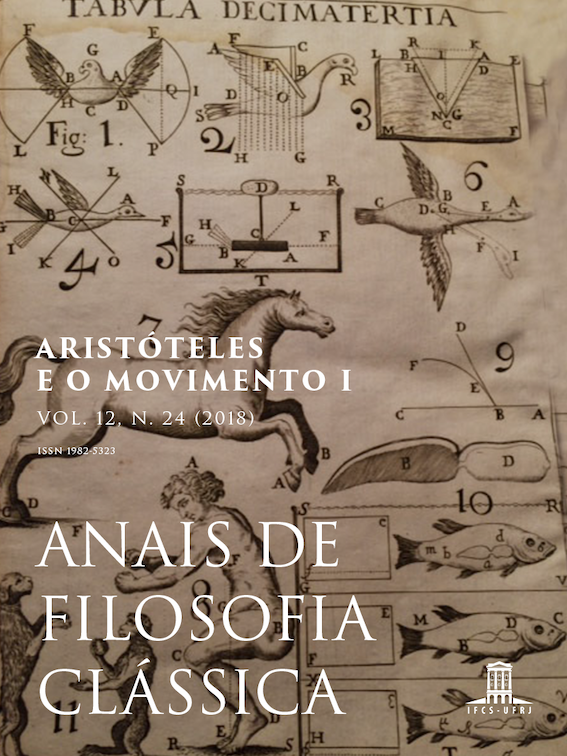O Espaço em Aristóteles: da bidimensionalidade do topos às seis diastaseis que definem os animais
DOI:
https://doi.org/10.47661/afcl.v12i24.22259Palabras clave:
Aristóteles, espaço, diastaseisResumen
Nesse trabalho, o que se pretende é apresentar – embora de forma resumida e ainda incompleta – como o problema da dimensionalidade é tratado naquele que é talvez o maior de todos os sistemas – o aristotélico. Em especial, queremos destacar o fato de que a dimensionalidade é um conceito importante para a compreensão da obra de Aristóteles, a partir da constatação de que é essencial para a compreensão do movimento – tema central desse Congresso – especialmente o self motionCitas
ARISTÓTELES. Usaremos neste ensaio edição a cura de BARNES, J. The Complete Works of Aristotle (the revised Oxford translation), vols. I e II, Princeton: Princeton University Press, 2a impressão, 1985, com traduções dos próprios autores, a menos que se diga o contrário.
ATMANANSPACHER, Harald. “The hidden side of Wofgang Pauli: An Eminent Physicist’s Extraordinary Encounter with Deep Psycology”. Journal of Counsciousness Studies, v. 3 (2): pp. 112-126, 1996.
BARROS, José Acácio de. Dois exemplos de indecidibilidade e incompletude em Física, Tese de Doutorado. Rio de Janeiro: CBPF, 1991.
BARROW, J.D. “Dimensionality”, Philosophical Transactions of the Royal Society of London, v. A310: p. 337, 1983.
BARROW, John D. & & TIPLER, Frank J. The Anthropic Cosmological Principle. Oxford: Oxford University Press, 1986.
BRAGUE, Remi. Aristote et la question du monde, Paris: Presses Univ. France, 1988.
BULCÃO, Marly. “A noção de imaginação: Bachelard crítico de Sartre”, in Constança Marcondes CÉSAR e Marly BULCÃO (Organizadoras). Sartre e seus contemporâneos. Aparecida: Ed. Ideias e Letras, 2008.
CARUSO, Francisco. “Life and space dimensionality: a brief review of old and new entangled arguments”, Journal of Astrobiology & Outreach, v. 4 (2): a.n. 152, 2016.
CARUSO, Francisco; MOREIRA XAVIER, Roberto. “Causa Efficiens versus Causa Formalis: origens da discussão moderna sobre a dimensionalidade do espaço”, Cadernos de História e Filosofia da Ciência, Série 3, v. 4 (2): p. 43-64, julho-dezembro de 1994.
_________. “On Kant’s First Insight into the Problem of Space Dimensionality and its Physical Foundations”, Kant-Studien, v. 106 (4): pp. 547–560, 2015.
_________. O livro, o espaço e a natureza: ensaio sobre a leitura do mundo, as mutações da cultura e do sujeito. São Paulo: Livraria da Física, 2017.
CASSIRER, Ernest. Philosophie der symbolischen Formen. Berlin: Bruno Cassirer, 1923. Tradução para o português: A Filosofia das Formas Simbólicas. São Paulo: Martins Fontes, vols. 1 e 2, 2004 e vol. 3, 2011.
COOPE, Ursula. “Self-motion as other-motion in Aristotle’s Physics”, in LEUNISSEN, Mariska (Ed.). Aristotle’s Physics: A Critical Guide. Cambridge: Cambridge University Press, 2015.
COSTA, Newton Carneiro Affonso da & DORIA, Francisco Antônio. “Undecidability and incompleteness in Classical Mechanics”, International Journal of Theorethical Physics, v. 30: p. 1041 (1991).
DE AQUINO, Thomas. In Octo Libros Physicorum Aristotelis Expositio, 1492. Edição utilizada Taurini: Marietti, 1965, p. 201, IV 282 (4), 8-11.
DES CHENE, Dennis. Physiologia: Natural Philosophy in Late Aristotelian and Cartesian Thought. Ithaca and London: Cornell University Press, 1996.
DUHEM Pierre. Le Système du Monde. Paris: Librairie Scientifique Hermann, v. 1, p. 197, 1913-1917.
_________. Medieval Cosmology: Theories of Infinity, Place, Void, and the Plurality of Worlds. Chicago and London: The University of Chicago Press, 1985.
EHRENFEST, Paul. “Welche Rolle spielt die Dreidimensionalität des Raumes in den Grundgesetzen der Physik?”, Annalen der Physik, v. 61: p. 440, 1920. Cf. também seu “In what way does it become manifest in the fundamental laws of physics that space has three dimensions?”, Proc. Amsterdam Acad., v. 20: p. 200, 1917 (Reimpresso em KLEIN, M.J. (ed.) Paul Ehrenfest – Collected Scientific Papers. Amsterdam: North Holland Publ. Co., 1959, pp. 400-409).
GALVÃO, Romiz. Vocabulário Etimológico, Ortográfico e Prosódico das Palavras Portuguêsas Derivadas da Língua Grega. Belo Horizonte: Livraria Garnier, 1994.
GILL, Mary Louise & LENNOX, James G. (Eds.). Self Motion: From Aristotle to Newton. Princeton, New Jersey: Princeton University Press, 1994.
GRANT, Edward. “The Principle of the Impenetrability of Bodies in the History of Concepts of Separate Space from the Middle Ages to the Seventeenth Century”, Isis, v. 69: pp. 551-71, 1978.
_________. Much Ado About Nothing: Theories of Space and Vacuum from the Middle Ages to the Scientific Revolution. Cambridge: Cambridge University Press, 1981. Veja também Max Jammer, op. cit.
KANT, Imanuel. Gedanken von der wahren Schätzung der lebendigen Kräfte und Beurtheilung der Beweise, deren sich Herr von Leibniz und andere Mechaniker in dieser Streitsache bedient haben, nebst einigen vorhergehenden Betrachtungen, welche die Kraft der Körper überhaupt betreffen, 1747. Akademie-Ausgabe (AA): GSK, AA 01.
GOTTHELF, Allan & LENNOX, James G. (Editors). Philosophical Issues in Aristotle’s biology. Cambridge: Cambridge University Press, 1987.
JAMMER, M. Concepts of Space: the History of Theories of Space in Physics. Cambridge: Harvard University Press, 3ª edição, 1993.
JUNG, Carl Gustav. O Homem e seus Símbolos. Rio de Janeiro: Nova Fronteira, 11a edição, 1992, p. 307.
KOYRÉ, Alexandre. Etudes Galiléannes. Paris: Hermann, 1966.
NEWMAN, James R. & NAGEL, Ernest. Godel’s Proof. NY: New York University Press, 1958.
PAULI, Wolfgang. “The Influence of Archetypal Ideas on the Scientific Theories of Kepler”, in JUNG, C.G. & PAULI, W. The Interpretation of Nature and Psyche. London: Routledge & Kegan Paul, 1955. Reprinted by Ishi Press, 2012. A esse respeito, veja também (ATMANANSPACHER, 1996).
POINCARÉ, Henri. Dernières Pensées. Paris: Ernest Flammarion, 1913.
POWERS, Jonathan. Philosophy and the New Physics. London and New York: Routledge, 1991.
SAMBURSKY, S. Physics of the Stoics. London: Routledge & Kegan Paul, 1959.
SCHENBERG, Mario. Pensando a Física. São Paulo: Ed. Brasiliense, 2a Ed, 1985.
SIMPLÍCIO. Física, 601, apud Jammer, op. cit.
SOMMERVILLE, Duncan M.Y. Bibliography of Non-Euclidean Geometry. Scotland: The University of St. Andrews, 1911.
VITELLI, H. (Ed.). Ioannis Philoponi in Aristotelis libros quinque posteriores commentaria. Berlin, 1888.
WEYL, Hermann. Philosophy of Mathematics and Natural Science. Princeton: Princeton University Press, 1949.
WHITROW, G.J. “Why Physical Space has three Dimensions”, British Journal for the Philosophy of Science v. 6: pp. 13-31, 1955.


